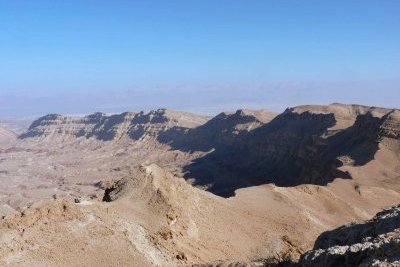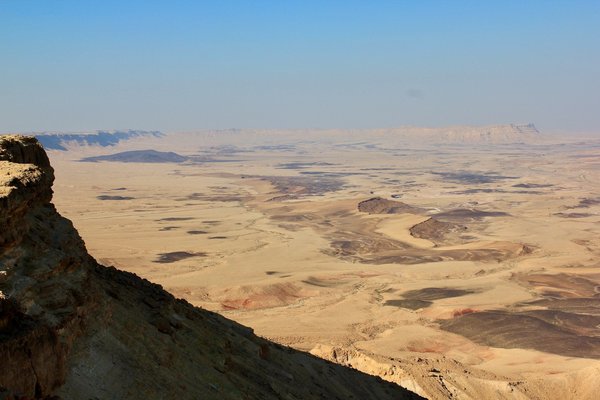Israel
Makhteshim Country
Makhteshhim Country is an area in the Negev Desert in southern Israel that is characterised by barren mountain ridges and deep, closed valleys called makhtesh. A makhtesh is a large erosion cirque created 220 million years ago when an ocean covered the area. It is a geological feature unique to the deserts of Negev in Israel and Sinai in Egypt. Makhtesh Ramon is the largest of these valleys with a length of 38 kilometres. Archaeological remains of nomads as well as Nabataean, Roman and Byzantine settlements have also been found in Makhteshhim Country.
Site Info
Official Information
- Full Name
- Makhteshim Country (ID: 1486)
- Country
- Israel
- Status
-
On tentative list 2001
Site history
History of Makhteshim Country
- 2005: Requested by State Party to not be examined
- Withdrawn on request of Israel
- 2001: Added to Tentative List
- Added to tentative list
- 2001: Deferred
- To turn the natural nomination into a mixed one
- Type
- Mixed
- Criteria
Links
- UNESCO
- whc.unesco.org
All Links
UNESCO.org
- whc.unesco.org — whc.unesco.org
Community Information
- Community Category
- Natural landscape: Eroded
- Cultural Landscape: Relict
Travel Information
Recent Connections
News
No news.
Community Reviews
Show full reviews
If you are driving on Route 40 to Eilat, you will go through Makhtesh Ramon, the largest and most well-known of makhteshim. In Mitzpe Ramon on its northern edge there is a visitor center and a chain of viewpoints over the geological formation. Viewpoints are all free to access, including that right by the visitor center. It is quite easy to take a look at the makhtesh with a reasonably short stop on you driving journey, which is what I did in November of 2019. I did not go inside the visitor center at all, and have no first-hand knowledge of what it might offer for a park-visiting fee. (Note that Israel Pass includes Mitzpe Ramon Visitor Center in its list.)
Makhtesh Ramon at first looks immense and sufficiently awe-inspiring, but after a few minutes of standing near the edge that impression started to dissipate. It is a large closed valley with steep walls, a landform that is apparently native only to the Negev desert and the Sinai peninsula. Maybe the relative uniqueness boosts its OUV, but I'll be surprised if it ever makes the inscribed list. Admittedly, I do not have a good gauge to evaluate OUV for purely natural monuments, so your mileage may vary.
Keep reading 0 comments
Erosion sites are a tricky topic. How unique or impressive must one be to have its own OUV? This is the question I ask when considering the makhteshim. I visited Makhtesh Ramon, the largest makhtesh, in May 2018. It was a few days after the flash floods, but when I got there, it was hazy from the dust. I couldn't see very far from the highway I was riding through, and the haze kept up when I reached the viewpoint from the visitor center in Mitzpe Ramon, on the cliffs forming the northern edge of the makhtesh. Despite this, it's not hard to see that it's a scenic site. It's almost like a canyon, but much wider and without a river. Although I didn't have time to engage in activities within the makhtesh due to time constraints, I had done prior research on what there was to do, in case I did have the time. What I found was quite interesting.
Within the makhtesh is a multitude of geological localities. From the viewpoint in Mitzpe, one can see clearly that there are many volcanic features in the landscape. Indeed, within this single erosional wonder, one can find magmatic dikes, hexagonal columns, volcanic and plutonic zones, colorful clay hills, ammonite and other fossil localities, and various mineral deposits. Together, they tell the long story of this little slice of the crust that has been exposed to us by this already great geological oddity.
Yes, the makhteshim have been described …
Keep reading 0 comments
We visited 3 of Israel’s 5 “Makhteshim” (out of 7 in the World according to Wiki with the others in Sinai.). They are certainly intriguing geological phenemona and at times even approach “impressive”. Although often called “Craters”, they are the result of erosion processes rather than impact and are claimed by Israel to be a geological formation unique to the Negev.
Little Makhtesh (Katan) and Big Makhtesh (Gadol) are close to each other and easily accessible when visiting Mamshit – just take Route 206 south from there. The first reached is Katan. This is signed along route 227. The last couple of kms are gravel (ok even for our very small rent-a-car) and then you need to park (signed) and walk the last kilometer or so to reach the overlook. We found this to be the most impressive of the makhtesh as, being the smallest, its sides are relatively close and it has an almost circular shape (Photo). You will then pass through Gadol if you make for the town of Yeruham along route 225. The cliff sides are visible but, unlike those of Katan, they do not give the impression of being part of a single structure. As you drive through you will pass an area of “Coloured sands” with picnic tables etc and loads of rubbish! We found the “banding” of the sands very disturbed by visitors and rather disappointing – distant views of other formations from the top of Katan were better. …
Keep reading 0 comments
